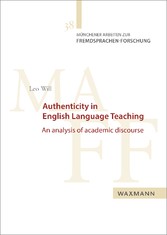Suchen und Finden
Service
Cover
1
Imprint
4
Preface
5
Contents
7
1 Introduction
11
1.1 Problem statement
11
1.2 Current state of research
12
1.3 Outline
14
2 Authenticity in EFL – a systematic overview
16
2.1 A comparison of three categorizations: Breen (1985), Decke-Cornill (2004), Gilmore (2007)
19
2.2 Text
25
2.2.1 The issue of authenticity versus genuineness
26
2.2.2 Definitions and underlying criteria of authentic text
27
2.2.2.1 Provenance
29
2.2.2.2 Inherent textual qualities
29
2.2.2.3 Aspects of post-production
31
2.2.2.4 Use of the text (appropriate response)
33
2.2.2.5 Uncommon criteria
34
2.2.2.6 Summary of the defining criteria
35
2.2.3 Authentic text genres
38
2.2.4 Final remarks on textual authenticity
43
2.3 Text reception
44
2.4 Individual behavior
46
2.5 Task
49
2.6 Social situation
53
2.7 Assessment
54
2.8 Culture
57
3 A conceptual taxonomy
60
3.1 Textual authenticity
60
3.2 Authenticity of text reception
60
3.3 Real-world authenticity
61
3.4 Classroom authenticity
61
3.5 Authenticity of individual behavior
62
3.6 Cultural authenticity
62
3.7 Elaborations on the conceptual taxonomy
63
4 Methodology
66
4.1 Discourse analysis as theory and method
67
4.2 The academic discourse
73
4.2.1 Authorial stance
74
4.2.2 Exclusiveness and author status
79
4.3 The EFL discourse
83
4.3.1 Authorial style
83
4.3.2 Citations
85
4.3.3 The relations between adequacy, style, stance, author status, and citation
86
4.4 The academic EFL discourse on authenticity
88
4.4.1 Demarcation – preliminary thoughts
89
4.4.2 Demarcation – mode, field, and tenor
89
4.4.3 Demarcation – explicit negotiation of terminology
90
4.4.4 Adjacent discourses
95
4.5 Compiling a document selection of authenticity in EFL
101
4.5.1 From demarcation to sampling – practical examples of explicit negotiation
102
4.5.2 The academic EFL discourse on authenticity – a document selection
107
4.5.3 Bibliometric analysis of the documents – productivity analysis and citation analysis
122
4.5.4 Text classification within the document selection
126
4.5.5 Temporal demarcation
127
4.5.5.1 An analysis of TESOL Quarterly
129
4.5.5.1.1 Casual use of authentic/authenticity before Widdowson (1976)
131
4.5.5.1.2 Focus on Stevick
133
4.5.5.1.3 Notable absence of the term
135
4.5.5.1.4 Summary – early use of the term
140
4.5.5.2 Authenticity and CLT
141
4.5.5.3 Concluding remarks on temporal demarcation
147
5 Chronological analysis of the academic EFL discourse on authenticity
149
5.1 On my role as an analyst
150
5.2 Chronological analysis by decade
151
5.2.1 1971–79 – the early years
152
5.2.1.1 Detailed analysis
154
5.2.1.2 Conclusion
160
5.2.2 The 1980s – decade of textual authenticity
162
5.2.2.1 Detailed analysis
166
5.2.2.2 Conclusion
171
5.2.3 The 1990s – broad adoption of Widdowson’s concept
172
5.2.3.1 Detailed analysis
176
5.2.3.2 Conclusion
185
5.2.4 The 2000s – persistent diversity
186
5.2.4.1 Detailed analysis
190
5.2.4.2 Conclusion
203
5.2.5 The 2010s – a new trend?
205
5.2.5.1 Detailed analysis
209
5.2.5.2 Conclusion
214
5.3 Summary of the chronological analysis
216
5.3.1 Bibliometrics informing discourse analysis: Productivity and citation
216
5.3.2 Findings of citation analysis
217
5.3.2.1 Amplification
217
5.3.2.2 EFL dictionaries
218
5.3.2.3 The German discourse
219
5.3.2.4 Electronic literature research
219
5.3.2.5 An egalitarian discourse?
220
5.3.3 Conceptual summary of the chronological analysis
221
6 The history of authenticity in EFL and beyond
226
6.1 The history of authenticity as a term outside of EFL
226
6.2 The history of textual authenticity as an EFL concept
228
6.2.1 Before 1600
229
6.2.2 17th century
230
6.2.3 18th century
232
6.2.3.1 Grammar books
234
6.2.3.2 Chrestomathies
236
6.2.4 1800–1881
237
6.2.5 1882 until the emergence of authentic/authenticity as a term (approx. 1970)
240
6.3 Summary
244
7 Six concepts of authenticity
248
Bibliography
253
Alle Preise verstehen sich inklusive der gesetzlichen MwSt.








